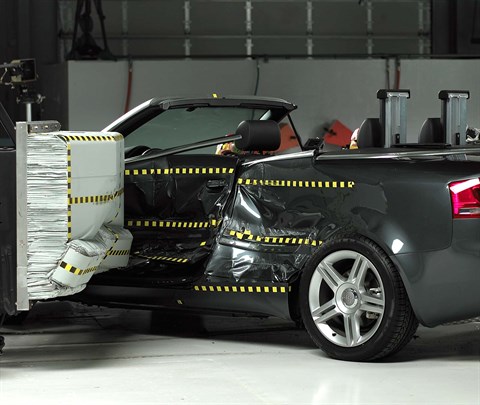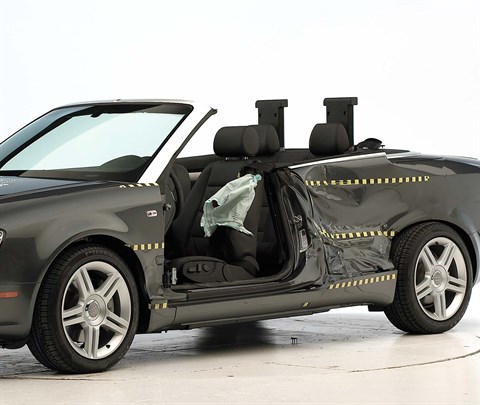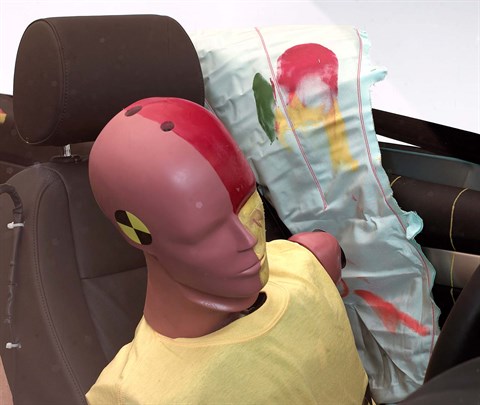Side: original test
Rating applies to 2003-09 models
Tested vehicle: 2007 Audi A4 Cabriolet 2.0T 2-door convertible with standard front seat-mounted combination head and torso airbags
The Audi A4 Cabriolet was redesigned for the 2003 model year.
| Evaluation criteria | Rating |
|---|---|
| Overall evaluation | |
| Structure and safety cage | |
| Driver injury measures | |
| Head/neck | |
| Torso | |
| Pelvis/leg | |
| Driver head protection | |
| Rear passenger injury measures | |
| Head/neck | |
| Torso | |
| Pelvis/leg | |
| Rear passenger head protection The dummy's head was hit by the interior side trim. This impact did not produce high head injury measures, but the head protection is inadequate. |
|

View of the vehicle and barrier just after the crash test.

View of the vehicle after the crash with door removed, showing the side airbag, pop-up rollover bars, and damage to the occupant compartment.

Smeared greasepaint shows where the driver dummy's head was protected from being hit by hard structures by the side airbag.

Smeared yellow, red, and green greasepaint shows where the rear passenger dummy’s head was hit by the interior side trim.
Measures of occupant compartment intrusion on driver side
| Test ID | CES0709 |
|---|---|
| B-pillar to longitudinal centerline of driver's seat (cm) | -17.0 |
| Negative numbers indicate the amount by which the crush stopped short of the seat centerline. | |
Driver injury measures
| Evaluation criteria | Measurement |
|---|---|
| Test ID | CES0709 |
| Head HIC-15 | 306 |
| Neck | |
| Tension (kN) | 1.6 |
| Compression (kN) | 0.0 |
| Shoulder | |
| Lateral deflection (mm) | 56 |
| Lateral force (kN) | 1.7 |
| Torso | |
| Maximum deflection (mm) | 55 |
| Average deflection (mm) | 49 |
| Maximum deflection rate (m/s) | 6.64 |
| Maximum viscous criterion (m/s) | 1.47 |
| Pelvis | |
| Iliac force (kN) | 0.7 |
| Acetabulum force (kN) | 1.8 |
| Combined force (kN) | 2.4 |
| Left femur | |
| L-M force (kN) | 0.7 |
| L-M moment (Nm) | 255 |
| A-P moment (Nm) | 48 |
Passenger injury measures
| Evaluation criteria | Measurement |
|---|---|
| Test ID | CES0709 |
| Head HIC-15 | 502 |
| Neck | |
| Tension (kN) | 1.9 |
| Compression (kN) | 0.0 |
| Shoulder | |
| Lateral deflection (mm) | 26 |
| Lateral force (kN) | 1.3 |
| Torso | |
| Maximum deflection (mm) | 18 |
| Average deflection (mm) | 13 |
| Maximum deflection rate (m/s) | 1.83 |
| Maximum viscous criterion (m/s) | 0.18 |
| Pelvis | |
| Iliac force (kN) | 1.2 |
| Acetabulum force (kN) | 2.0 |
| Combined force (kN) | 3.0 |
| Left femur | |
| L-M force (kN) | 0.4 |
| L-M moment (Nm) | 73 |
| A-P moment (Nm) | -21 |
Head restraints & seats
Seat type: Power leather seats
| Overall evaluation | |
|---|---|
| Dynamic rating | |
| Seat/head restraint geometry |
| Seat type | Power leather seats |
|---|---|
| Geometry | |
| Backset (mm) | 68 |
| Distance below top of head (mm) | 42 |
| Seat design parameters | |
| Pass/fail | Fail |
| Max T1 acceleration (g) | 13.9 |
| Head contact time (ms) | 90 |
| Force rating | 3 |
| Neck forces | |
| Max neck shear force (N) | 184 |
| Max neck tension (N) | 977 |
About the head restraint & seat test
Currently, IIHS tests apply only to front seats.